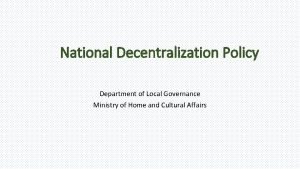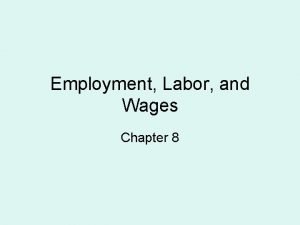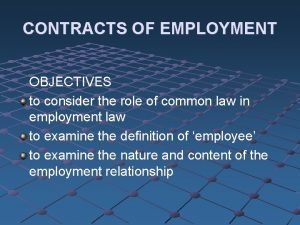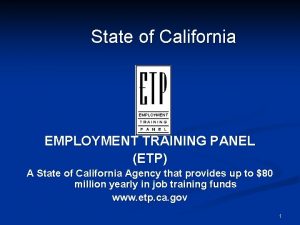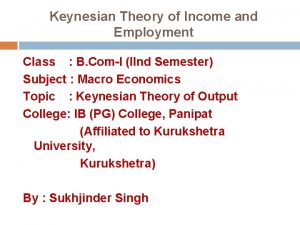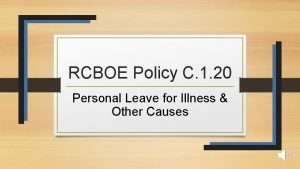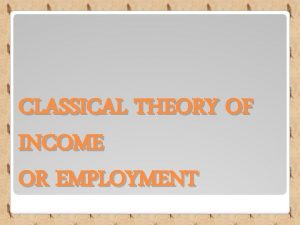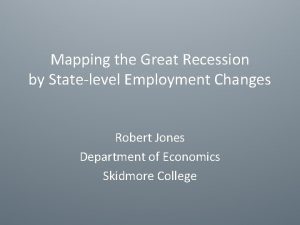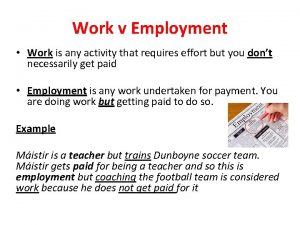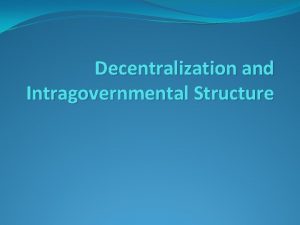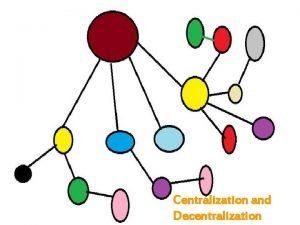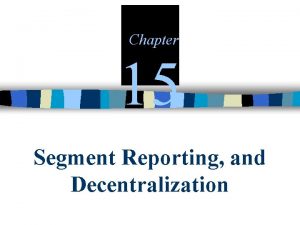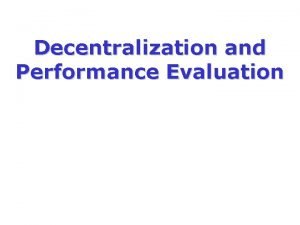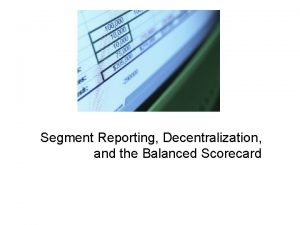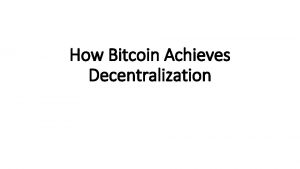Decentralization of Population Decentralization of Employment 60 Largest
































































- Slides: 64

Decentralization of Population

Decentralization of Employment; 60 Largest Metro Areas


Concentration of Poverty


Overview of Welfare Economics • • Pareto Efficiency Supply & Demand Market Equilibrium Marginal Costs & Marginal Benefits Market Failure Externalities Public Goods Common Resources

“A planner’s primary obligation is to serve the public interest. ” - AICP Code of Ethics and Professional Conduct

Welfare Economics: The study of how different forms of economic activity and different methods of allocating scarce resources affect the well-being of individuals or communities Pareto Efficiency: An allocation of resources is considered Pareto efficient if no alternative allocation can make at least one person better off without making someone else worse off

Supply & Demand

Demand The relationship between the price of a good/service and the quantity purchased by consumers Law of Demand: All else being equal, quantity demanded decreases as price increases. (Negative relationship between price and quantity = downward slope)

Demand

Supply The relationship between the price of a good/service and the quantity that producers are willing to supply Law of Supply: All else being equal, quantity produced increases as price increases. (Positive relationship between price and quantity = upward slope)

Supply

Supply and Demand




MB


Social Surplus Consumer Surplus: The difference between what consumers are willing-to-pay and what they have to pay Graphically, the area under the demand curve and above the price Producer Surplus: The difference between producers’ total revenue and marginal cost Graphically, the are above the supply curve (MC) and below the price

Consumer Surplus

Producer Surplus

Social Surplus Consumer Surplus: The difference between what consumers are willing-to-pay and what they have to pay Graphically, the area under the demand curve and above the price Producer Surplus: The difference between producers’ total revenue and marginal cost Graphically, the are above the supply curve (MC) and below the price

Social Surplus

Realities of the Market The private market only ensures efficiency under strict conditions, including: w w w Many buyers and sellers (no monopolies) Identical goods and services Perfect information No barriers to entry No externalities (side effects) w … Even a “perfectly competitive” private market: w w cannot effectively allocate public goods or common resources Does not address issues of distribution or equity…

“Four Vital Functions of Planning” (Klosterman, 1985) Argument for and Against Planning 1. Improves information for public and private decision making 2. Considers external effects of individual and group action 3. Promotes collective interest, esp. w/ respect to public goods 4. Considers distributional effects of market actions (equity)

Market Failure Externalities: Economic side effects or “spillovers. ” costs or benefits that stem from an economic activity, but that affect people other than those directly involved in a market transaction. Can be POSITIVE or NEGATIVE

Market Failure Example of negative externality Driving involves direct cost: gas, driver’s time …and creates indirect, or external, costs: pollution, congestion, road maintenance, etc. The individual driver does not bear the indirect costs, and does not consider them in his/her decisionmaking process

Market Failure Example of positive externality: A beekeeper’s bees create benefits that can be captured: honey, sold to customers … and external benefits that cannot be captured: bees pollinate nearby orchards The orchard farmers do not pay the beekeeper for this benefit, so the beekeeper does not consider it in his decision-making process

Figure 2 Pollution and the Social Optimum Price of Aluminum Social cost Cost of pollution Supply (private cost) Optimum Equilibrium Demand (private value) 0 QOPTIMUM QMARKET Quantity of Aluminum Copyright © 2004 South-Western

Figure 3 Education and the Social Optimum Price of Education Supply (private cost) Social value Demand (private value) 0 QMARKET QOPTIMUM Quantity of Education Copyright © 2004 South-Western

Market Failure Public Goods: Defined by non-rivalrous consumption and non-excludability w Non-rivalrous consumption: Good or service can be used by one person without detracting from the ability of other to use it w Non-excludability: Impossible or impractical to exclude some people from enjoying the benefits of a good service, even if they are unwilling to pay for it

Topics w Budgets § especially revenue sources, – Especially taxes w Guidelines for Evaluating Taxes w Equity: Progressive / Regressive Taxes w The Tax Wedge, Elasticity, and Incidence


Guidelines for Evaluating Taxes Ease of Administration Equity 1. Ability to pay (progressivity vs. regressivity) 2. Benefit principle of taxation Efficiency 1. Effect on social surplus (welfare) 2. Ability to raise revenue

Tax Equity Progressive: Burden of tax increases w/ income. Higher inc households spend a greater percentage of their income on the tax than lower income households. Regressive: Burden of tax decreases w/ income. Higher inc households spend a smaller percentage of their income on the tax than lower income households Proportionate: Burden of the tax remains the same over all levels of income



The Efficiency Effects of a Tax Price Supply Price buyers pay Size of tax Price without tax Price sellers receive Demand 0 Quantity with tax Quantity without tax Quantity Copyright © 2004 South-Western

The Effects of a Tax Levied on Sellers Price P* + t Size of tax Supply (MC ) P* Demand 0 Q* Quantity Copyright © 2004 South-Western

The Effects of a Tax Levied on Sellers Price Supply (MC Price buyers pay Size of tax ) Price without tax Price sellers receive Demand (MB) 0 Quantity with tax Quantity without tax Quantity Copyright © 2004 South-Western

The Effects of a Tax Levied on Buyers Price Supply (MC ) P* Size of tax P* - t Demand 0 Q* Quantity Copyright © 2004 South-Western

The Effects of a Tax Levied on Buyers Price Supply (MC Price buyers pay ) Size of tax Price without tax Price sellers receive Demand 0 Quantity with tax Quantity without tax Demand (MB) Quantity Copyright © 2004 South-Western

The Efficiency Effects of a Tax Price Supply (MC Price buyers pay Size of tax ) Price without tax Price sellers receive Demand 0 Quantity with tax Quantity without tax Quantity Copyright © 2004 South-Western

Tax Incidence The party that actually pays the tax to the government (whether that is the seller or buyer) can pass part of that tax forward to consumer, or backward to the producer. The party that the tax is shifted to bears the tax incidence The incidence depends on price elasticity of supply and demand

Elasticity The incidence of taxation, the amount of deadweight loss caused by a tax, and the amount of revenue raised by a tax all depend on how responsive the quantity supplied and quantity demanded are to changes in price

The Efficiency Effects of a Tax Price Supply (MC Price buyers pay Size of tax ) Price without tax Price sellers receive Demand 0 Quantity with tax Quantity without tax Quantity Copyright © 2004 South-Western

The Efficiency Effects of a Tax Price MC Size of tax 2. 50 Size of tax Supply (MC ) 2. 00 1. 50 Demand 0 Quantity Copyright © 2004 South-Western

Tax Incidence and Elasticities Inelastic Demand Price Supply 2. 75 Size of tax 2. 00 1. 75 Demand 0 Quantity Copyright © 2004 South-Western

Tax Incidence and Elasticities Elastic Demand Price Supply 2. 25 2. 00 Size of tax Demand 1. 25 0 Quantity Copyright © 2004 South-Western

Tax Incidence and Elasticities Inelastic Supply Price Supply Size of tax Demand 0 Quantity Copyright © 2004 South-Western

Tax Incidence and Elasticities Elastic Supply Price Size of tax Supply Demand 0 Quantity Copyright © 2004 South-Western

Tax Distortions and Elasticities (c) Inelastic Demand Price Supply Size of tax When demand is relatively inelastic, the deadweight loss of a tax is small. Demand 0 Quantity Copyright © 2004 South-Western

Tax Distortions and Elasticities (d) Elastic Demand Price Supply Size of tax Demand When demand is relatively elastic, the deadweight loss of a tax is large. 0 Quantity Copyright © 2004 South-Western

Tax Distortions and Elasticities (a) Inelastic Supply Price Supply When supply is relatively inelastic, the deadweight loss of a tax is small. Size of tax Demand 0 Quantity Copyright © 2004 South-Western

Tax Distortions and Elasticities (b) Elastic Supply Price When supply is relatively elastic, the deadweight loss of a tax is large. Size of tax Supply Demand 0 Quantity Copyright © 2004 South-Western

Corrective Tax (negative externalities) (Social MC) Price Size of tax Supply (Pvt MC) P* P Demand (MB) 0 Q* Q Quantity Copyright © 2004 South-Western

The Effects of a Tax on Social Surplus Price Supply Price without tax Demand 0 Quantity without tax Quantity Copyright © 2004 South-Western

The Effects of a Tax on Social Surplus Price Supply Price buyers pay Size of tax (T) Tax revenue (T × Q) Price sellers receive Demand 0 Quantity with tax Quantity without tax Quantity Copyright © 2004 South-Western

Deadweight Loss and Tax Revenue from Three Taxes of Different Sizes (a) Small Tax Price Deadweight loss Supply PB Tax revenue PS Demand 0 Q 2 Q 1 Quantity Copyright © 2004 South-Western

Deadweight Loss and Tax Revenue from Three Taxes of Different Sizes (b) Medium Tax Price Deadweight loss PB Supply Tax revenue PS 0 Demand Q 2 Q 1 Quantity Copyright © 2004 South-Western

Deadweight Loss and Tax Revenue from Three Taxes of Different Sizes (c) Large Tax Price PB Tax revenue Deadweight loss Supply Demand PS 0 Q 2 Q 1 Quantity Copyright © 2004 South-Western


Sprawl Traits 1. 2. 3. 4. 5. 6. 7. Unlimited outward extension of development Low-density residential/comm. development Widespread strip commercial Leapfrog development Auto dependence (private auto) Segregation of land uses by zones Reliance on trickle down or filtering process to provide housing to low income HH 8. Lack of centralized control of land uses 9. Fragmentation of power over land use (many localities) 10. Great fiscal disparity among localities Burchell, Robert. (1998) The Costs of Sprawl – Revisited. Transportation Cooperative Research Program Report 39. Washington, DC: National Academy Press.
 The largest canadian subculture is
The largest canadian subculture is Midwest mfg uses a balanced scorecard
Midwest mfg uses a balanced scorecard Decentralization
Decentralization Decentralization
Decentralization Decentralization
Decentralization Decentralization policy
Decentralization policy Advanced cost and management accounting ppt
Advanced cost and management accounting ppt Decentralization
Decentralization Advantages of decentralization
Advantages of decentralization Decentralization accounting
Decentralization accounting Centralization vs decentralization
Centralization vs decentralization Population ecology section 1 population dynamics
Population ecology section 1 population dynamics Population ecology section 1 population dynamics answer key
Population ecology section 1 population dynamics answer key Population ecology section 1 population dynamics answer key
Population ecology section 1 population dynamics answer key Population ecology section 1 population dynamics
Population ecology section 1 population dynamics Ohio employment first
Ohio employment first Amherst college employment
Amherst college employment Veterans employment opportunity act
Veterans employment opportunity act Cisva employment
Cisva employment Employment parity
Employment parity Gila river employment and training
Gila river employment and training Employment communication
Employment communication Northwest isd employment
Northwest isd employment Www.nsz
Www.nsz During the great depression union promoters
During the great depression union promoters Kentucky national guard agr jobs
Kentucky national guard agr jobs Nethermere v gardiner
Nethermere v gardiner Stuttering and employment discrimination
Stuttering and employment discrimination Www.nsz
Www.nsz Employment training panel sacramento
Employment training panel sacramento Vocabulary world of work
Vocabulary world of work English for your career 1
English for your career 1 Overcoming barriers to employment
Overcoming barriers to employment What is employment structure
What is employment structure Roman: employment
Roman: employment Moodfx
Moodfx Ulrike storost
Ulrike storost Standard employment contract (id407)
Standard employment contract (id407) Jasper city schools employment
Jasper city schools employment Ward employment specialist
Ward employment specialist Evergemail.com
Evergemail.com Explain the keynesian theory of employment
Explain the keynesian theory of employment Rcboe
Rcboe Unrwa
Unrwa Higher business management
Higher business management Shifters of srpc
Shifters of srpc Classical theory of income and employment
Classical theory of income and employment Ncae results 2014
Ncae results 2014 Supported employment verktøykasse
Supported employment verktøykasse Public employment programmes
Public employment programmes Employment first
Employment first Employment equity amendment bill
Employment equity amendment bill Triangular employment
Triangular employment Department of labor employment workshop
Department of labor employment workshop Qut careers
Qut careers Cpolrhp belvoir army mil eur index htm
Cpolrhp belvoir army mil eur index htm Employment correspondence
Employment correspondence Equal employment opportunity illinois
Equal employment opportunity illinois What's a psp report
What's a psp report Csbsju jobs
Csbsju jobs Self-employment income examples
Self-employment income examples What is employment activity
What is employment activity Udg100
Udg100 Sweden public employment service
Sweden public employment service Executive employment agreement checklist
Executive employment agreement checklist





